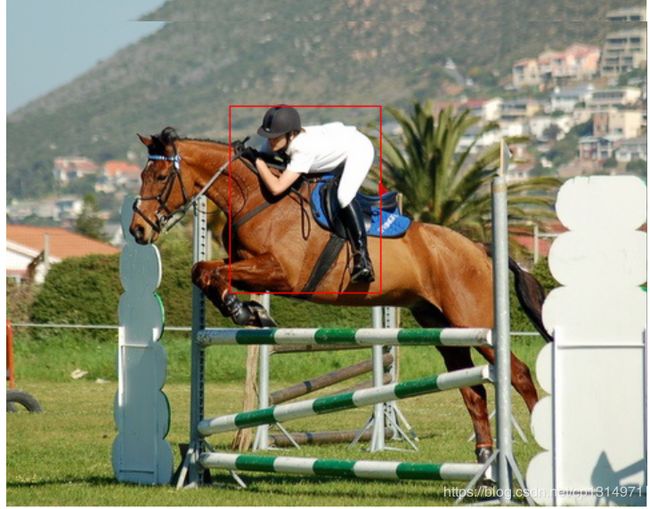pytorch 目标检测数据增强 详细讲解
摘要
目标检测中的数据增强是比较复杂,每一次改变图像同时也要考虑boxes的信息,比起目标分类更加局限性,比如翻转,左右翻转一般影响不大,但上下翻转造成的影响就截然不同。下面操作坐标点全是xyxy形式
resize操作
先来看下对比,在图片大小改变的同时也要改变boxes的位置信息,第一张是原图


我截图是一样大小,可以看出框的位置依旧准确,原图是(480,364)变化后的是(300,300),对比之前的照片清晰度明显下降,所以训练照片差距太多再好的模型也难以起到很好的效果。下面是代码实现
import math
import random
import torch
from PIL import Image, ImageDraw
def resize(img, boxes, size, max_size=1000):
w, h = img.size #(480, 364)
print('wwww',w)
print('hhhh',h)
if isinstance(size, int): #这里是按照高和宽等比例缩放
print('is============')
size_min = min(w,h) #这里我以输入300为例
size_max = max(w,h) #首先找到最小额一边,缩放的边是364,
sw = sh = float(size) / size_min #计算出高缩放的比例,将宽缩放到同等比例
print('sw',sw)
print('sh',sh)
if sw * size_max > max_size: #放置缩放过大
sw = sh = float(max_size) / size_max
print('ifl====',sw)
ow = int(w * sw + 0.5) #向上取整
print('ow',ow)
oh = int(h * sh + 0.5)
print('oh',oh)
else:
print('else============') #这里输入的就是(300,300)
ow, oh = size
print('ow',ow)
print('oh',oh)
sw = float(ow) / w
print('sw',sw)
sh = float(oh) / h #计算高和框的缩放比例,boxes乘以这个比例即可
print('sh',sh)
print('boxex',boxes*torch.Tensor([sw,sh,sw,sh]))
return img.resize((ow,oh), Image.BILINEAR), \
boxes*torch.Tensor([sw,sh,sw,sh])
def draw(img, boxes):
draw = ImageDraw.Draw(img)
for box in boxes:
draw.rectangle(list(box), outline='red')
img.show()
def test():
img = Image.open('G:\detection\image/1.jpg')
boxes = torch.Tensor([[167, 63, 280, 202]])
img, boxes = resize(img, boxes,(300,300))
print(img.size)
draw(img, boxes)
test()
数据增强的写法有二种,一种是利用库中自带的图像操作,自己只需要写boxes的变化规则就可以,另一种全部自己实现,在这里我肯定利用前者,比较方便。
resize的变化规则这里我写了二种,一种是输入300,另一个边按照长宽比进行缩放,另一种输入(300,300)高和宽固定缩放到(300,300)的大小。
center_crop操作
也先来看下效果

这个操作只是将你输入的大小部分截取出来,其他的没有任何变化,使用这一个操作对数据集不同也要做相应的改变,我这张照片只标注了一个人,在中间的位置,如果有其他边缘位置的信息,你就需要利用平移在取中间部分效果才好,不能漏掉原有的信息。具体代码实现
def center_crop(img, boxes, size):
w, h = img.size
ow, oh = size
i = int(round((h - oh) / 2.)) #同样我们只需要将照片二边需要减掉的高和宽计算出来
print('i',i)
j = int(round((w - ow) / 2.))
print('j',j)
img = img.crop((j, i, j+ow, i+oh)) #利用自带的图像处理,选取图像固定位置
print(img.size)
print('bo',boxes)
boxes -= torch.Tensor([j,i,j,i]) #将boxes减去就可以需要的boxes位置信息
print('boxes',boxes)
boxes[:,0::2].clamp_(min=0, max=ow-1) #clamp函数是用来防止超出边界
print('bo1',boxes)
boxes[:,1::2].clamp_(min=0, max=oh-1)
print('bo2',boxes)
return img, boxes
random_flip操作
随机水平翻转,这个算是最常用的操作了,boxes的位置计算也简单
def random_flip(img, boxes):
if random.random() < 0.5:
img = img.transpose(Image.FLIP_LEFT_RIGHT) #0.5的概率随机翻转
w = img.width
xmin = w - boxes[:,2] #计算左顶角的位置 高的位置都不变
xmax = w - boxes[:,0] #计算右低角的位置
boxes[:,0] = xmin
boxes[:,2] = xmax
return img, boxes
random_crop操作
随机截取是比较复杂的,需要截取的规范,不能超出边界,还要保证框的位置在截取范围内,所以就需要尝试截取位置,如果尝试10次都失败的话就截取中间部分

这个操作也只是把周围的背景随机的剪掉,
def random_crop(img, boxes):
success = False
for attempt in range(10):
area = img.size[0] * img.size[1]
print('000',img.size[0])
print('111',img.size[1])
print('area',area)
target_area = random.uniform(0.56, 1.0) * area
print('target_area',target_area) #生成随机大小区域
aspect_ratio = random.uniform(3. / 4, 4. / 3) #再次随机大小
print('aspect_ratio',aspect_ratio)
w = int(round(math.sqrt(target_area * aspect_ratio)))
print('w',w) #计算高和宽
h = int(round(math.sqrt(target_area / aspect_ratio)))
print('h',h)
if random.random() < 0.5:
print('=============0.5')
w, h = h, w
if w <= img.size[0] and h <= img.size[1]: #宝成截取规范,不能超出边界
print('+++++++++++wh')
x = random.randint(0, img.size[0] - w)
print(x)
y = random.randint(0, img.size[1] - h)
print(y)
success = True
break
# Fallback
if not success:
print('NONO',success) #尝试10次都不满足的话就直接中间截取
w = h = min(img.size[0], img.size[1])
print('w',w)
x = (img.size[0] - w) // 2
print('x',x)
y = (img.size[1] - h) // 2
print('y',y)
print('box',boxes)
print('img',img.size)
img = img.crop((x, y, x+w, y+h))
print('bianhua img',img.size)
boxes -= torch.Tensor([x,y,x,y])
print('boxes',boxes)
boxes[:,0::2].clamp_(min=0, max=w-1)
boxes[:,1::2].clamp_(min=0, max=h-1)
print('final',boxes)
return img, boxes
(480, 364)
000 480
111 364
area 174720
target_area 99011.19318377912
aspect_ratio 1.1786427101246018
w 342
h 290
+++++++++++wh
30
41
box tensor([[167., 63., 280., 203.]])
img (480, 364)
bianhua img (342, 290)
boxes tensor([[137., 22., 250., 162.]])
final tensor([[137., 22., 250., 162.]])
(342, 290)
全部代码
import math
import random
import torch
from PIL import Image, ImageDraw
def resize(img, boxes, size, max_size=1000):
w, h = img.size
print('wwww',w)
print('hhhh',h)
if isinstance(size, int):
print('is============')
size_min = min(w,h)
size_max = max(w,h)
sw = sh = float(size) / size_min
print('sw',sw)
print('sh',sh)
if sw * size_max > max_size:
sw = sh = float(max_size) / size_max
print('ifl====',sw)
ow = int(w * sw + 0.5)
print('ow',ow)
oh = int(h * sh + 0.5)
print('oh',oh)
else:
print('else============')
ow, oh = size
print('ow',ow)
print('oh',oh)
sw = float(ow) / w
print('sw',sw)
sh = float(oh) / h
print('sh',sh)
print('boxex',boxes*torch.Tensor([sw,sh,sw,sh]))
return img.resize((ow,oh), Image.BILINEAR), \
boxes*torch.Tensor([sw,sh,sw,sh])
def center_crop(img, boxes, size):
w, h = img.size
ow, oh = size
i = int(round((h - oh) / 2.))
print('iiii==',i)
j = int(round((w - ow) / 2.))
print('jjjjjjj',j)
img = img.crop((j, i, j+ow, i+oh))
print(img.size)
print('bo',boxes)
boxes -= torch.Tensor([j,i,j,i])
print('boxes',boxes)
boxes[:,0::2].clamp_(min=0, max=ow-1)
print('bo1',boxes)
boxes[:,1::2].clamp_(min=0, max=oh-1)
print('bo2',boxes)
return img, boxes
def random_flip(img, boxes):
if random.random() < 0.5:
img = img.transpose(Image.FLIP_LEFT_RIGHT)
w = img.width
print('boex',boxes)
xmin = w - boxes[:,2]
print('xmin',xmin)
xmax = w - boxes[:,0]
print('xmax',xmax)
boxes[:,0] = xmin
boxes[:,2] = xmax
print('final',boxes)
return img, boxes
def draw(img, boxes):
draw = ImageDraw.Draw(img)
for box in boxes:
draw.rectangle(list(box), outline='red')
img.show()
def random_crop(img, boxes):
success = False
for attempt in range(1):
area = img.size[0] * img.size[1]
print('000',img.size[0])
print('111',img.size[1])
print('area',area)
target_area = random.uniform(0.56, 1.0) * area
print('target_area',target_area)
aspect_ratio = random.uniform(3. / 4, 4. / 3)
print('aspect_ratio',aspect_ratio)
w = int(round(math.sqrt(target_area * aspect_ratio)))
print('w',w)
h = int(round(math.sqrt(target_area / aspect_ratio)))
print('h',h)
if random.random() < 0.5:
print('=============0.5')
w, h = h, w
if w <= img.size[0] and h <= img.size[1]:
print('+++++++++++wh')
x = random.randint(0, img.size[0] - w)
print(x)
y = random.randint(0, img.size[1] - h)
print(y)
success = True
break
# Fallback
if not success:
print('NONO',success)
w = h = min(img.size[0], img.size[1])
print('w',w)
x = (img.size[0] - w) // 2
print('x',x)
y = (img.size[1] - h) // 2
print('y',y)
print('box',boxes)
print('img',img.size)
img = img.crop((x, y, x+w, y+h))
print('bianhua img',img.size)
boxes -= torch.Tensor([x,y,x,y])
print('boxes',boxes)
boxes[:,0::2].clamp_(min=0, max=w-1)
boxes[:,1::2].clamp_(min=0, max=h-1)
print('final',boxes)
return img, boxes
img = Image.open('G:\detection\image/1.jpg')
print(img.size)
boxes = torch.Tensor([[167, 63, 280, 203]])
draw(img,boxes)
img, boxes = random_crop(img, boxes)
print(img.size)
draw(img, boxes)
自己可以去查看img自带的更多操作,配合自己写boxes部分可以写出更多的数据增强操作,这里的写法没有封装成compose的操作,直接使用函数就可以。
具体使用
def __getitem__(self, idx):
boxes = self.boxes[idx].clone()
labels = self.labels[idx]
size = self.input_size
# Data augmentation.
if self.train:
img, boxes = random_flip(img, boxes)
img, boxes = random_crop(img, boxes)
img, boxes = resize(img, boxes, (size,size))
else:
img, boxes = resize(img, boxes, size)
img, boxes = center_crop(img, boxes, (size,size))
img = self.transform(img)
return img, boxes, labels
在getitem中返回目标检测基本大部分都是返回img,boxes,labels的形式,当然我用的yolo3就不是,但是原理是一样的,你只需要将img,和boxes经过之前写好的函数就行,在封装成你自己的形式就可以